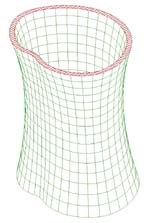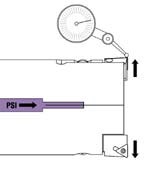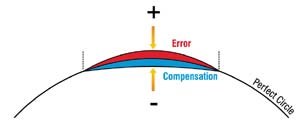A Boring System For Non-Round Holes
Machining an out-of-round bore is easy if you're not particular about the location or magnitude of the roundness error. But accurately machining a hole that has a precisely defined non-round profile is a capability that would seem to be well beyond what a standard boring bar can accomplish.
Machining an out-of-round bore is easy if you're not particular about the location or magnitude of the roundness error. But accurately machining a hole that has a precisely defined non-round profile is a capability that would seem to be well beyond what a standard boring bar can accomplish. The boring bar able to cut such a profile would have to extend and retract its cutting diameter at precise locations around each revolution of the tool.
Makino (Mason, Ohio) has been working on boring technology to accomplish exactly that. Servo-controlled coolant pressure moves a boring tool's cutting diameter in and out, in coordination with the angular position of the tool as it rotates at speeds around 1,000 rpm. The result is an ability to machine "shaped bores"—bores that have precisely controlled out-of-round features. These features don't even have to be axially symmetric.
Who can use the technology? The company sees diesel engine manufacturers as the primary candidates. Controlling the profile of an engine cylinder bore can ensure a better fit between bore and piston, and therefore lower emissions when the engine is in use. Government-mandated emissions standards are making this an increasingly important consideration.
In manufacturing such an engine, the goal is still to produce bores that are as close as possible to being perfectly round and straight. However, machining a hole that is deliberately out-of-round may be the only way to arrive at a round bore in the end. Assembly forces and the thermal effects of running the engine are just two of the influences that can introduce various roundness errors after the boring operation is complete. The only way to compensate for these errors at the machine tool is to machine equal and opposite errors into the bore before these other influences come into play.
Stan Weidmer is the Makino engineer principally involved with developing the shaped bore process. Modeling software, he says, now makes it possible for engine manufacturers to predict the roundness errors that will result from these downstream effects. The ability to machine shaped bores complements this capability by offering a way to machine features that mirror the predicted errors.
The shaped-bore process builds on Makino's Coolant Adjustable Boring Bar system, or "CABB," which has been available for about 3 years. This system uses coolant pressure for tool actuation, applying pressure to a reservoir of coolant inside the boring bar to force apart the tool's cutting edges. The system was originally developed to machine bores that are intended to be round, but taper or flare along the hole's length.
Mr. Weidmer says several characteristics of the CABB technology made it possible to extend the system to the machining of shaped bores. The servo update time for the coolant pressure is short enough to adjust the tool diameter repeatably during each revolution and still keep up a reasonable spindle speed. Also important are the stiffness and damping of the CABB tool itself, features that make the tool rigid enough so cutters retract cleanly whenever coolant pressure is relaxed.
The system consists of more than just the boring tool, which by itself is mechanically simple. Also important to this process are the CNC algorithms and coolant-delivery modifications that achieve closed-loop control for the coolant pressure, as well as in-process gaging that allows the system to compensate for tool wear across a long run of parts. In short, it takes a Makino machine to use the CABB technology.
This system's effectiveness at machining shaped bores to the level of accuracy required for engine production has been demonstrated experimentally, Mr. Weidmer says, but field testing is needed. The company is currently searching for a partner in this testing—an engine manufacturer able to provide the opportunity to subject this process to an authentic production run.
Related Content
Buying a Lathe: The Basics
Lathes represent some of the oldest machining technology, but it’s still helpful to remember the basics when considering the purchase of a new turning machine.
Read MoreSelecting a Thread Mill That Matches Your Needs
Threading tools with the flexibility to thread a broad variety of holes provide the agility many shops need to stay competitive. They may be the only solution for many difficult materials.
Read MoreHow to Turn Machine Shop Downtime Into Process Expertise
To take advantage of a lull in business, JR Machine devised a week-long cutting tool event that elevated the shop’s capabilities with aerospace alloys.
Read MoreAll-Around Mill Improves Productivity and Cost for Valve Job
Adopting a mill with a double-negative rake and pockets compatible with multiple insert geometries enabled Progressive Metal Service to increase feed and lower scrap rates for a valve.
Read MoreRead Next
Obscure CNC Features That Can Help (or Hurt) You
You cannot begin to take advantage of an available feature if you do not know it exists. Conversely, you will not know how to avoid CNC features that may be detrimental to your process.
Read More3 Mistakes That Cause CNC Programs to Fail
Despite enhancements to manufacturing technology, there are still issues today that can cause programs to fail. These failures can cause lost time, scrapped parts, damaged machines and even injured operators.
Read MoreThe Cut Scene: The Finer Details of Large-Format Machining
Small details and features can have an outsized impact on large parts, such as Barbco’s collapsible utility drill head.
Read More
.jpg;width=70;height=70;mode=crop)





























